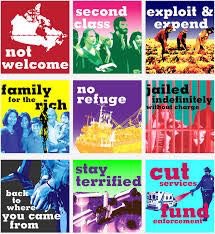Refugee Racial Discrimination in North America
1. What is Racial discrimination ?
2. Contributing factors to racial inequality within Canada .
6. Recognition: a Philosophy by Fredrich Hegel
What is racial discrimination?
Discrimination is segregation based on characteristics that are outcasted, different and racially othered. International law prohibits discrimination on the basis of race, gender, and colour.
Different treatment is often counted as discrimination when favouring a 'dominant' or 'superior' within society. See dominant or superior here.

.
Where does Discrimination start?
Discrimination of New Refugees begins from how we perceive the places and culture which many refugees come from. Often times, woman of Arab or Middle Eastern descent are assumed to be oppressed, belonging to a culture that is highly patriarchal, fanatically religious, violent, and uncivilized. All of them above are problematic when they are more than just stereotypes and actually take practice when they are presented as traits of Arab or Middle Eastern peoples from a specific culture/country. To unpack all of these descriptions is beyond the scope of this assignment, because any characteristic or trait can be problematized when it Is attributed to an entire group of people that is seen as a homogenous package. According to the Huffington Post, discrimination against displaced people is not limited to Europe, the U.S. and Canada of course, but it extends well beyond hateful political rhetoric. In truth, millions of refugees around the world face discrimination and the fear behind it on a daily basis. This has critical implications not only for security and stability in refugee-receiving (and refugee-rejecting) nations, but for population health and economic growth as well (Huffington Post, 2016).
Contributing factors to racial inequality within Canada
- Stereotypes
- Fear
- Othering
- Superiorty
- Irrationality
- Lack of Understanding
- Discriminatory Laws and political stances
Refugee Immigration
Refugees who are new to Canada or any nation potentially face discrimination or racism at some point in time during their stay in Canada. Refugee racial discrimination is worsened by racialized stereotypes, and language. When refugees are brought into North America, or any place where they may face discrimination based on their skin colour, religious beliefs, traditional cultural customs, there can be a result of problematic mentalities amongst the refugees, which then becomes an issue amongst themselves and their community. This leads us to the idea of Internalized Oppression.
Internalized oppression - Acceptance - and Low Self- Worth
Internalized oppression is one of the steps in the process of Internalized oppression; It refers to the ways in which members of subordinate groups consciously or unconsciously believe, agree with, collide with, and/or incorporate the oppressive conditions, perspectives, and messages put forth by oppressive systems. This can include messages about one’s social identities, other subordinate or dominant group identities, as well as messages about entitlement (or lack thereof), how the world is, and how the world should be. Internalized Oppression affects how we navigate space, and how we recognize ourselves and allow others to recognize or mis-recognize us.For example: To be an Arab refugee coming to North America is to now be painted as a muslim, even if you are Catholic, or Jewish. To be misinterpreted before you speak, and to be labelled before you are properly recognized by all your fellow members of society.
- It is important to note that Internalized Oppression leads to low self worth, which eventually takes a negative toll on some refugees which can then lead them to drop out from school, and steer towards gang and street related activity, thus, stapling the stereotype to the new immigrants - and making them become a reality to those who did not want them to enter their nation in the first place.
The language of Othering
The language of Racial 'Othering' is a contributing factor that increases racial inequality. Racial Othering is experienced when an individual or a group becomes classified in someone else's mind as “ not one of us”, an “other”; and spoken words diminish the othered person’s place and value. Numerous communities that we spoke of in class face the language of 'othering' on a daily basis in Canada, such as refugees - especially those from the Middle East, and Africa.
An ethnic group which faces extreme language of 'othering' are those who come from the Middle East and Near East region. Arabs and middle easterners face a large amount of discrimination which is mostly brought in via Social media and media outlets. The negative stereotyping of Arabs and negative association with them has created many issues when it comes to immigration within Canada and refugees coming from Syria or Iraq.

In his book, 'Reel Bad Arabs' (2003), Professor Jack Shaheen reported what he calls an injustice after he viewed more than 900 Hollywood movies negatively portraying Arab men, women and children in very unappealing, unattractive, and inhuman ways. Dr. Shaheen (2003) notes that Hollywood‘s stars have been vanquishing reel Arabs in movies as early as 1917. When Arabs were not vanquished, they were often described with derogatory slurs and referred to as dogs and monkeys (Shaheen, 2003). This is part of the ways in which Arabs have become 'Othered' within society, and viewed as the “Orient, or the other”.
Recognition & Mis-recognition
We need to make sure we do not mis-recognize a group of people for something they are not, and that is why recognition play an important role in diminishing racial inequality: Friedrich Hegel’s philosophy of recognition; Recognition has both a normative and a psychological dimension. Arguably, if you recognize another person with regard to a certain feature, as an autonomous agent, for example, you do not only admit that he/she/they have this feature but you embrace a positive attitude towards them for having this feature. Such recognition implies that you bear obligations to treat them in a certain way, that is, you recognize a specific normative status of the other person, e.g., as a free and equal person (Young, 1990) . Most theories of recognition assume that in order to develop a practical identity, persons fundamentally depend on the feedback of other subjects (and of society as a whole).
Sources:
1) Bayoumi, Moustafa . “How does it feel to be a problem?”: being young and Arab in America . New York: Penguin Press, 2008 pp. 176-181.
2) Fanon, F. (1952). “Black Skin, White Masks” New York: Grove Press 1967. Pp. 46-49.
3) Freire, P. (1970). Pedagogy of the oppressed. New York, NY: Continuum. 1970. pp. 30-31.
4) Shaheen, Jack G. “Reel bad Arabs:” how Hollywood vilifies a people . New York: Olive Branch Press , 2001.
5) Shaheen, Jack G. “The TV Arab”. Bowling Green, Ohio:: Bowling Green State U Popular Press, 1984. Pp.32-38.
6) https://www.jstor.org/stable/1049860 - Jack Shaheens Bio and Research.
7) http://www.huffingtonpost.com/lindsay-stark/the-high-cost-of-refugee-_b_9017842.html - The high cost of Refugee Discrimination.